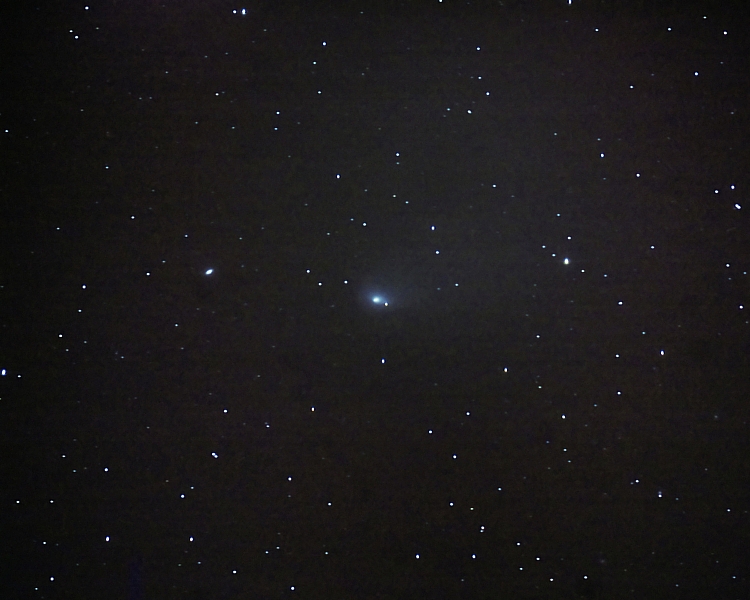With the absence of air-traffic Saturday night was looking good for observing. There was no wind, stable air, clear skies and hardly any sign of the dreaded Icelandic dust. The plan was to have a look for comets, and to see if I could bag one with the camera. A quick look on the CalSky site indicated that Comet 81P/Wild (pronounced Vilt) might be worth a shot. It's a tiny target - currently in the constellation of Virgo, it's low down, quite dim and well beyond the capability of my binoculars - so it was a scope-job. 81P/Wild is quite a significant comet - NASA targeted it for one of their missions - see here and here.
It took me ages to find the target with the 8" Newt even with the GOTO, primarily because the software's datafile for comets is wrong, leading to a huge positional error. Undeterred, I opted for Plan B - I got the comet's true coordinates from CalSky and plugged them into the software, and soon found the required bit of sky. A thorough look through the eyepiece revealed hardly anything, so I ditched that idea and slapped on the D50 at prime-focus with the intent of taking a series of long exposures. I wanted to be taking frames with exposures in the 5-10 minutes range, so I needed to use the other scope and the webcam as an autoguider, but there was no suitably bright and well-positioned guide-star anywhere near the target. Typical. No matter, I'd just have to make do with shorter exposures, but more of them. It wasn't an ideal situation, but it was better than nothing.
After a few hours I'd got what I needed, having taken a series of light and dark frames for the stacking-software to mull over. By that time a haze had started to develop which meant that the session was over. I packed up and started to process the data before heading in for some shut-eye.
So, here are the results:
(Mouseover for the annotated version, click for the biggie)
Comet 81P/Wild (the bluish smudge) in the centre, NGC5493 (a galaxy) to the left of centre, the other labelled items are stars.
53 light and 45 dark frames restricted to 60 second exposure times due to the lack of guiding.
Stacked in DSS and post-processed with PSCS3.
Here's a cropped and enhanced version. This is about the best I can get it, no doubt others could do much better with the data:
I'm quite pleased with that. I don't usually have the patience to deal with the slow pace of imaging the faint fuzzy things up there, but I'm glad that I persisted. If I get another chance, I'll try to get some longer, guided exposures to see how much improvement can be achieved.








Hi, have not been successful in finding any info on possible Lyrid meteor sighting from North London early this morning (20th April 2010). I should add that I'm a complete novice but would welcome any expertise on what I witnessed. Not being able to sleep I lay looking at the night sky out of my west-facing window from bed. At precisely 3.30am I saw the most vivid blue single metor, stream downward with a bright head very long tail. Excuse my lack of technical descriptiveness – it streamed downward in a south-westerly direction, and appeared at an angle (looking upward from my bed) of about 45 degrees. I've witnessed meteor showers both here and the continent in recent years – most memorably being the one several years ago in August when it was announced on the news that a meteor shower would be particularly vivid and also visible from London. I recall those having a greenish tinge to the tail. But they were not as bright as this one.
Can anyone tell me if this might be a Lyrid. From what I've managed to find on the web the best time is 22-23rd April 2010 (?). I added this comment here because I wonder if the volcanic dust cloud had any effect on the strength of the display?
@Amzie - Hi. The timing's right for a Lyrid sighting, and the Lyrids shower often produces "fireballs" - see http://spaceweather.com/meteors/lyrids/lyrids.html and http://www.imo.net/calendar/2010#lyr
Thanks for your expertise here BG. I thought it unusual because it was not the peak date, and due to its apparent intensity, as viewed from London.